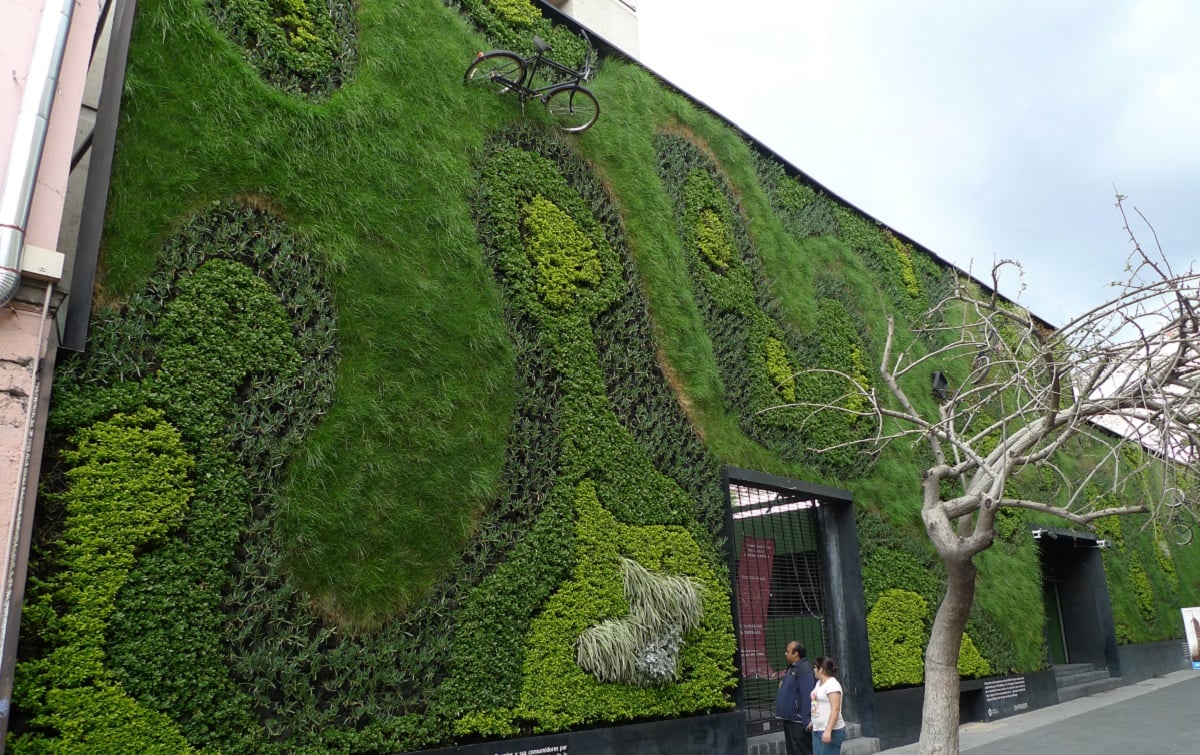
The writing’s on the wall, they say. Now the plants are, too. Green walls, aka living walls or vertical gardens, have grown in popularity in recent years, especially in urban areas. They are everywhere, from front yards to corporate offices to art museums. It’s never been easier to learn how to create a living landscape wall for your home.
So, what exactly is a green wall? How does it work? Could you include one in your own home or landscape design? And why would you even want to? We’ll explore everything you could possibly want to know about the eco-friendly craze that is green walls.
Origins of Green Walls
The concept of growing plants on walls has been around for thousands of years, but landscape architecture professor Stanley Hart White was the first to patent vertical gardens as we know them today. He had the idea way back in 1938, but it didn’t really grow on people until decades later.
In the 1980s and 1990s, a French botanist named Patrick Blanc began to popularize green wall systems as a method of urban agriculture. He sought to improve biodiversity in big cities with his massive living wall designs.
With the rise of Patrick Blanc, living green walls started popping up all over the place, in residential and commercial spaces, indoors and outdoors.
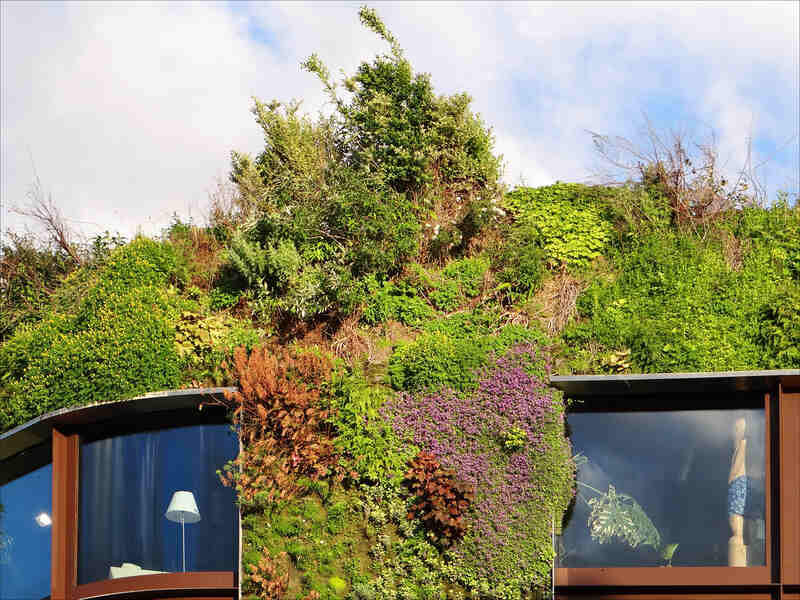
Photo Credit: Jean-Pierre Dalbéra / Wikimedia Commons / CC BY 2.0
Note: Especially in the 2010s, with environmental sustainability rising to the forefront of public thought, these green garden walls became popular with businesses and homeowners alike.
Benefits of Green Walls
People don’t just like living walls because they look pretty. They can also make a building more energy-efficient and have positive impacts on people’s health and well-being.
These are a few of the benefits of having a green wall in a home or commercial space:
- Exterior: An outdoor green wall adds an extra layer of insulation to a home or building. That means it takes less energy to keep the inside cool in the summer and warm in the winter. In urban environments, outdoor living walls also improve the general air quality and reduce heat island effects.
- Interior: An indoor living wall supplies the inside of a home or building with fresh, oxygen-rich air. They also filter out indoor air pollutants like VOCs.
VOCs (volatile organic compounds) are organic chemicals found in human-made products such as paints, cleaning supplies, pesticides, and building materials. They can have negative short-term or long-term effects on health. VOC levels are up to 10 times higher for indoor air than outdoor.
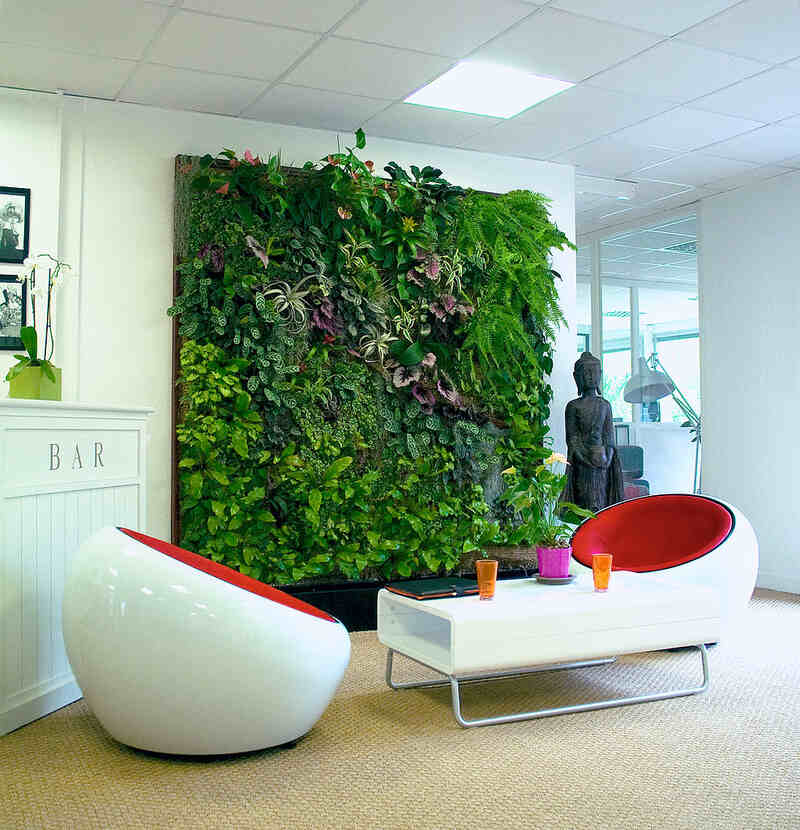
Photo Credit: Spaceo / Wikimedia Commons / CC BY-SA 3.0
- Indoor and outdoor green walls also can block out excessive noise, reducing a space’s sound pollution (much like a privacy hedge does).
- Of course, as with any garden, there’s also an aesthetic appeal to green walls. With the right plant selection, a vertical garden can easily liven up any landscape or living room.
If plants aren’t your thing and low-maintenance is, a moss wall might be more up your alley. Like regular green walls, moss walls are vertical living garden structures that use moss rather than traditional plants.
Many of these walls use preserved moss and folia (preserved plants). Moss walls:
- Require no sunlight and need very minimal maintenance
- Have a long life span
- Like green walls, block out excessive noise
How Green Walls Work
To understand how a living wall functions, there are a few fancy terms you’ll need to get familiar with.
Substrate: A “substrate” is simply the base on which an organism lives. When we’re talking about plants, the substrate is the material in which the plant takes root (usually soil).
Growing medium: In this context, “growing medium” means the exact same thing as “substrate.”
Hydroponics: “Hydroponics” is a frilly scientific word that just means growing plants using water and nutrients, but without using soil.
So, in a green wall system, panels create a vertical surface that holds the growing medium, or substrate. Depending on what kind of green wall you build, your options for growing media include loose, mat, sheet, or structural (we’ll get into what each of those means in just a second).
Some green walls use soil as a substrate, but many use other materials. Those that don’t use soil work through hydroponics. Without soil, proper watering becomes imperative for a vertical garden. That’s why most of them have a built-in irrigation system.
Irrigation systems for living walls range from simple DIY drip irrigation with PVC pipes to automatic recirculation systems that reuse the same water over and over again. A recirculation system will make the green wall more water-efficient, but it’ll also cost a pretty penny.
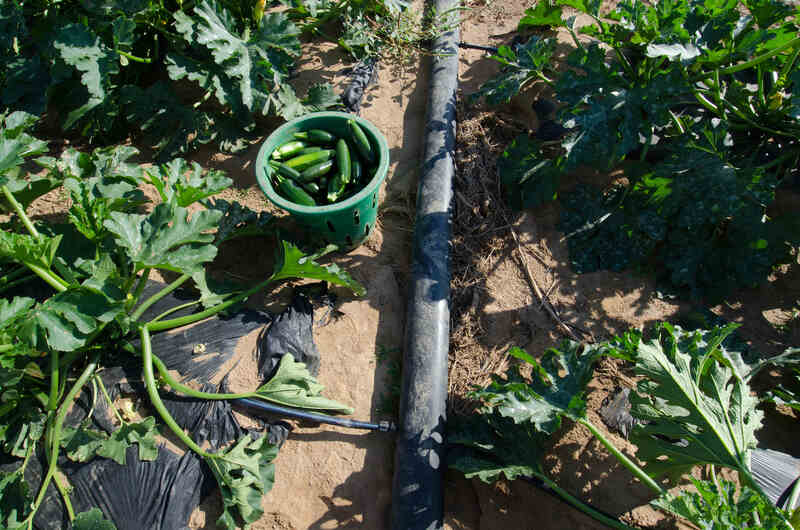
Photo Credit: U.S. Department of Agriculture / Flickr / Public Domain
Living Walls vs. Green Facades
Living walls and green facades may appear similar, but they are not the same. While living walls consist of plants that are rooted into a vertical surface, green facades are made up of plants with their roots in the ground, which naturally grow on a wall or fence (such as vines, ivy, and other climbing plants).
Types of Green Walls
The type of green wall depends on what material is used as the growing medium. As we already mentioned, the four types are loose media, mat media, sheet media, and structural media.
Loose Media
Loose growing media really just means soil. For this type of green wall, plants take root in small mounds of soil in a bag or on a shelf. These are the easiest green walls to make, so they’re common for home gardeners.
One thing to remember about a loose media green wall: You have to replace the soil regularly. You’ll need to change it out at least once a year for an exterior living wall and every two years for an interior one.
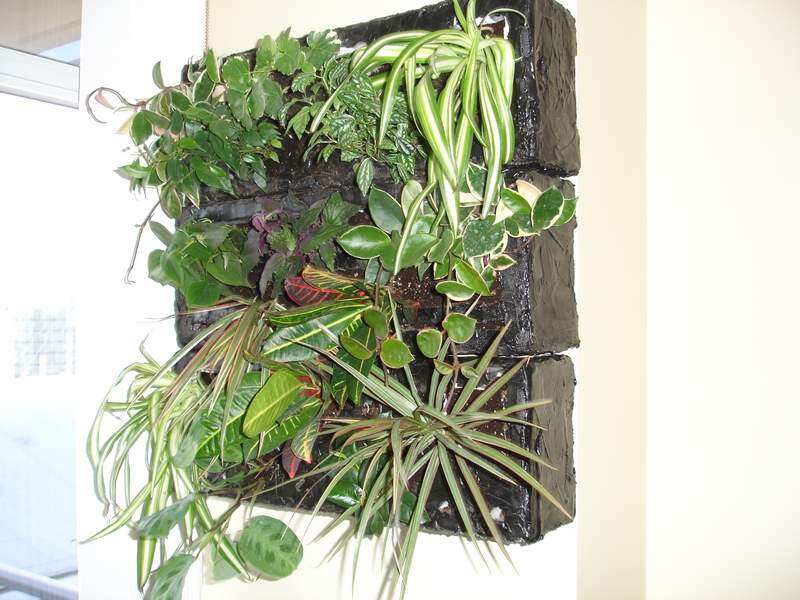
Photo Credit: Isupereco / Wikimedia Commons / CC BY-SA 3.0
Mat Media
In a green wall made with mat media, plants take root in mats made of coir fiber or felt instead of soil. So, in this case, the mat is the substrate/growing medium.
Mat media is another type of living wall that’s easy for home gardeners to plant and maintain, but beware. Coir fiber and felt mats are thin, so they don’t retain much water. They also can’t hold large plants with long, thick roots without tearing the fabric. These are best for small plants and small spaces.
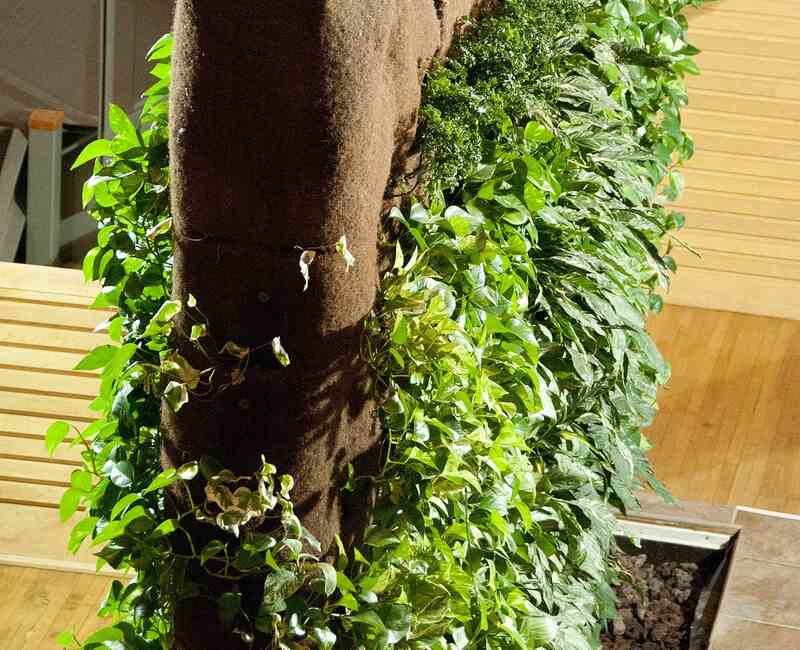
Photo Credit: M. Rehemtulla / Wikimedia Commons / CC BY 2.0
Sheet Media
Sheet media works similarly to mat media. Essentially, sheet media is the upgraded version because it consists of plastic sheets with an egg carton-like pattern that gives them more depth and texture. Sheet media retains water better than mat media and can hold larger plants without tearing.
The other benefit to using plastic is that it won’t decompose. Sheet media tends to last much longer than mat media. Sometimes, you can use the same sheet in your green wall for up to 20 years.
Structural Media
Now we’ve come to the slightly more complicated type of living wall system. Structural media is usually used for large, professionally installed green walls. That doesn’t mean you can’t have one for your home, it just means you might need to hire a professional to build it for you.
A green wall with structural media uses blocks of soil (or another substrate) as the growing medium. The blocks come in varying sizes, shapes, and thicknesses, so they can accommodate just about any species of plant you want.
Structural media is another longer-lasting option. These typically last 10-15 years.
How to Make a Green Wall for Your Home or Landscape
DIY green wall construction can get a little complicated, and it involves power tools. If you don’t have a lot of experience with construction projects, you might want to hire a professional landscaper to build your green garden wall for you.
If you’ve got veteran DIY chops and you’re ready to make a green wall for yourself, check out this step-by-step video of a DIY living wall from Home Depot:
Step 1: Choose a Structure
Your structure depends entirely on personal preference. You can use any of the above media with your choice of wooden or container structure.
Before you start your green wall installation, make sure the spot you’ve chosen gets enough sunlight for the plants you want to grow. If you’re making an indoor green space, keep in mind that you’ll most likely need some sort of artificial light source to keep your plants healthy.
Note: It’s a good idea to keep in mind the wall that you’ll be hanging your structure on in case of water damage. Make sure the surface won’t be damaged easily by your irrigation.
Step 2: Line It
Depending on your type of green wall structure (loose, mat, sheet, or structural), you’ll want to line it. This is particularly important for wooden structures in order to prevent wood rot.
Use plastic to line each planting section where there will be soil and plants. Staple the plastic down once it’s in place and cut away the excess.
Step 3: Irrigation
You also will need to decide what kind of irrigation system you want before you install your living wall. Are you willing to water your vertical garden regularly by hand, or would you rather have an automatic one that connects to a tank and pump? Your decision will affect the cost and construction process of your green wall.
Typical watering methods, such as a watering can or hose, won’t work for a vertical garden.
Step 4: Plant Selection
When thinking about plants, you should first consider what growing media you want to use, as now would be the time to put in your soil set-up for your plants. This might involve loose, mat, sheet, or structural media.
For an outdoor wall, it’s best to use native plants that can survive your local weather conditions and temperature changes. Consult with a local nursery on what plants would be best for your area.
For an indoor wall, your options are less limited. You won’t have to worry about choosing plants that can survive your local overall temperatures since the plants will be in a climate-controlled area. Vibrant tropical plants are common for indoor green walls.
Either way, the best plants for a vertical garden are ones with shallow root systems:
- Succulents
- Vines
- Herbs
These are an especially good choice if you’re using mat media that can tear easily under a lot of weight.
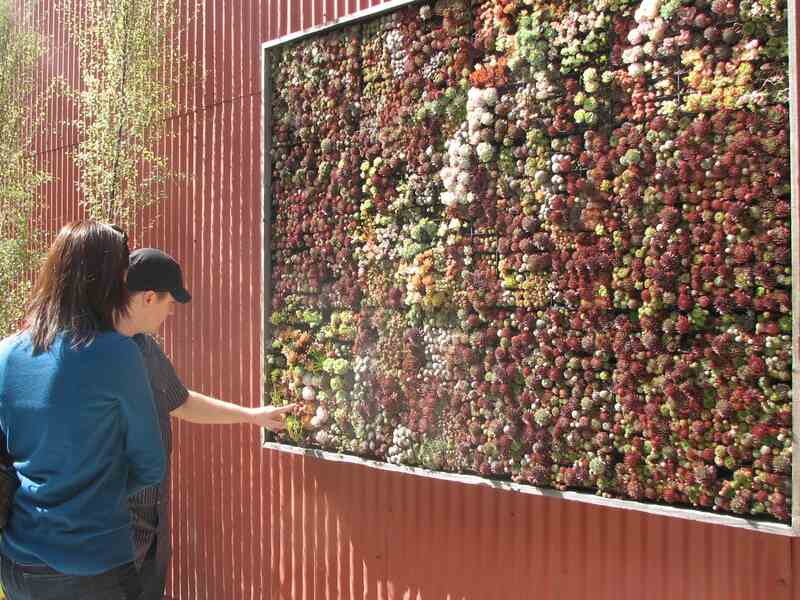
Photo Credit: Seán A. O’Hara / Flickr / CC BY 2.0
Once you’ve selected your greenery, it’s a good idea to transplant small specimens into your wall instead of trying to grow them from seeds. When you plant them, make sure you give each plant plenty of room to grow so they don’t choke each other in the future.
FAQ
How Much Does a Living Wall Cost?
Cost depends on several variables, including what kind of growing medium you use, how big you want your wall to be, and what plant species you choose. A small green wall with loose media and a simple irrigation system is the cheapest way to go.
How Do You Maintain a Green Wall?
The most important part of maintaining your green wall is making sure the plants get enough water. Your watering schedule will vary based on the plant species you use and the amount of sunlight the wall gets. Like all growing plants, regular fertilization will keep your green wall happy and healthy.
You’ll also want to make sure you remove any dead plants, roots and all. And remember if you use soil, you’ll need to replace it every one or two years.
Do Green Walls Reduce Stormwater Runoff?
Typically, vertical gardens have little to no impact on stormwater runoff. If you’re looking for a solution to a runoff issue on your property, consider a rain garden instead.
Call the Professionals
Now that you know everything about how to make a living wall, maybe it’s time to add a DIY green wall to your landscape. With these vertical gardens, the sky (or rather, the wall) is the limit. For help with your new green or living wall, call a landscaping professional near you.
Main Photo Credit: Mark Hogan / Flickr / CC BY-SA 2.0